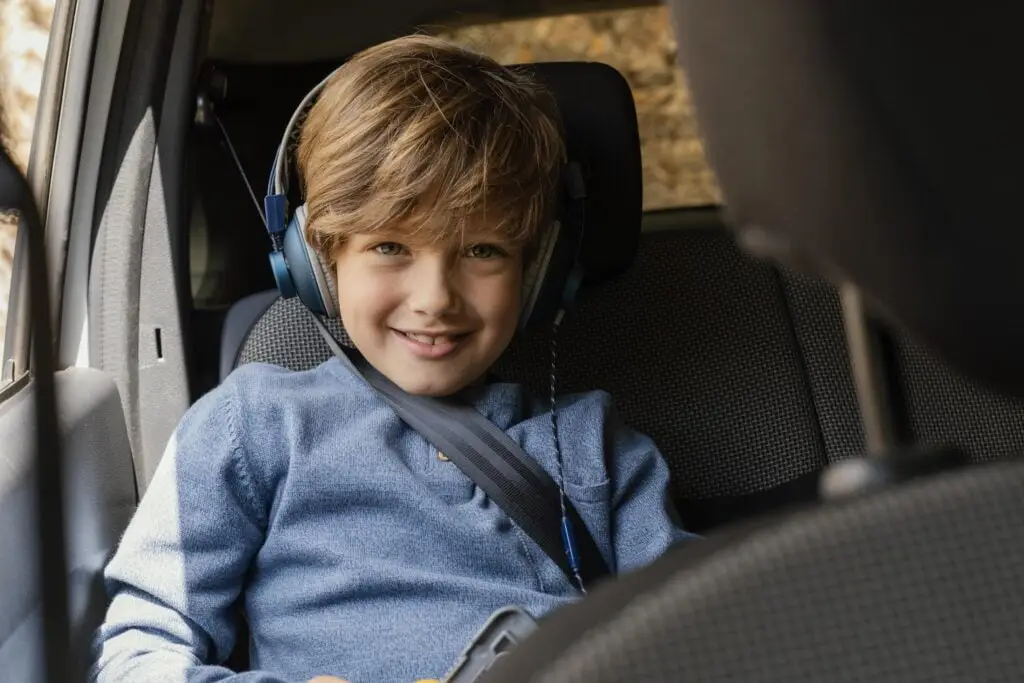When Can a Kid Sit in the Front Seat? A Simplified Guide for Parents
Emma feels wonder and envy as her older brother, James, quickly unbuckles and hops out of his front seat. From her booster seat in the back, she eagerly asks when it will be her turn to sit up front. For many parents, this moment is a milestone, signalling their child’s growing independence.
Children often want to imitate their older siblings or parents by sitting in the front seat. While it may seem like a different view for them, it raises significant safety concerns for parents. The question becomes: when can a kid sit in the front seat safely?
Understanding the Importance of Seat Safety
Car safety for children should be a top priority for every parent. Ensuring young passengers’ well-being is not just recommended but essential. Children are more vulnerable to serious injury during an accident because car safety features like airbags and seat belts are designed mainly for adults.
Why Rear Seats Are Safer:
- Airbags: While airbags protect adults, they can be dangerous for children because they are smaller.
- Seat Belts: Designed for adult bodies, they may not fit children properly and could fail to protect them adequately.
Safety Guidelines:
- Experts recommend that children stay in the rear seats until they reach a certain age or height.
- Properly using child safety seats and keeping children in the rear seats significantly reduces the risk of death and injury in accidents.

Legal Requirements
Knowing when can a kid sit in the front seat requires understanding legal requirements, which vary by region and state. These regulations aim to protect young passengers from potential harm.
Common Legal Guidelines:
- Many states require children to be at least 12 years old and meet specific weight limits before sitting in the front seat.
- Booster seats or other safety devices are often recommended until children reach a certain height.
Guidelines for Sitting Comfort in the Front Seat
According to the American Academy of Pediatrics (AAP), children should be at least 13 years old before making this transition. This age guideline ensures they can fully benefit from front-seat safety features.
Key Considerations:
- Age Recommendation: Children should be at least 13 years old.
- Height and Weight: Safety measures are designed with average adult proportions.
- Proper Seatbelt Fit: Lap belts should sit across the upper thighs, not the stomach; shoulder belts should cross the chest without cutting into the neck or face.
- Airbag Concerns: Airbags can cause severe injuries if a child is seated too close to the dashboard.
Expert Opinions and Research
Determining when can a kid sit in the front seat is informed by expert opinions and research:
Pediatrician Recommendations:
- Children under 13 should not ride in front seats due to increased crash injury risk.
NHTSA Data:
- Children under 13 are 50% less likely to sustain serious injuries when sitting in the rear seat.
- Advanced airbag systems can cause significant injuries to children, even in minor collisions.
Practical Parenting Advice for Front Seat Safety
Parenting children who want to know when can a kid sit in the front seat can be challenging. Here are some practical tips:
- Educate with Age-Appropriate Language: Due to airbags and sudden stops, explain that sitting in the back is safer.
- Make the Back Seat Appealing: Install a tablet holder, provide engaging games, or let them choose music.
- Celebrate Safe Transitions: Ensure they understand all safety precautions once they meet the criteria for front-seat seating.
- Manage Emotional and Social Dynamics: Use open communication, positive reinforcement, and clear milestones.
- Divert Focus with Fun Experiences: Make sitting in the backseat exciting with special privileges like selecting music or interactive games.

Recommended Products
Enhance your child’s safety with these highly recommended car seats:
- Chicco KidFit 2-in-1 Belt-Positioning Booster Car Seat
- The Chicco KidFit offers head and shoulder protection with its DuoZone combined head and shoulder side-impact protection. It also converts from a high-back booster to a backless booster.
- Evenflo Maestro Sport Harness Booster Car Seat
- This car seat transitions from a 5-point harness to a belt-positioning booster, accommodating children from 22 to 110 lbs. It features an upfront harness adjustment for easy access.
- Safety 1st Grow and Go All-in-One Convertible Car Seat
- The Safety 1st Grow and Go is built to grow with your child from rear-facing (5–40 lbs) to forward-facing (22–65 kg) to belt-positioning booster (40–100 kg).
- BubbleBum Inflatable Backless Booster Car Seat
- This inflatable, portable booster seat is perfect for travel, carpooling, and taxis. It’s designed for children aged 4–11, weighing 40–100 lbs.
Conclusion
Understanding when can a kid sit in the front seat is vital for protecting children during car travel. Adherence to guidelines on age, weight, and state-specific legislation plays an essential role in mitigating risks and increasing protection during travel.
By following these recommendations on when kids can sit in the front seat, parents can significantly reduce potential dangers associated with front-seat travel for younger children. Ensuring adherence to these guidelines fulfills legal requirements and dramatically enhances your child’s safety.
For more helpful parenting tips, check out the article Teach Your Kid to Ride a Bike in Just 3 Easy Steps!. This guide provides simple and effective strategies to help your child learn how to ride a bike confidently and safely.





































































